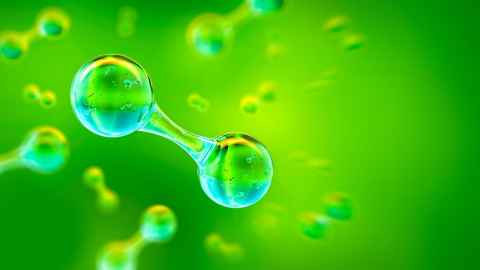Harnessing hydrogen
28 September 2022
Green hydrogen could be a major contributor in decarbonising New Zealand’s energy sector.

If the Government's recently commissioned ‘Hydrogen Roadmap’ is anywhere near correct, green hydrogen could account for around eight per cent of New Zealand’s total energy demand by 2050 and support decarbonisation in export markets in countries like Japan, Korea and Singapore.
Vehicles powered by hydrogen (H2) are already being trialled and, starting in 2023, Taranaki-based Hiringa Energy plans to assemble a nationwide green hydrogen refuelling network for the heavy transport sector. There’s even talk of the South Island’s Manapouri hydro station being converted into the world’s largest hydrogen production facility – once the Tiwai Point smelter closes.
“New Zealand’s in quite an enviable position that we can make lots of electricity in a green and sustainable manner which we can then use to produce hydrogen fuel,” says Chemical Sciences Associate Professor Geoff Waterhouse. “Potentially, we can completely decarbonise New Zealand’s energy sector, and also have these exciting export opportunities in the Asia-Pacific region around hydrogen.”
New Zealand has great capacity to create electricity.
Metal single atom catalysts
However the transition to a green hydrogen economy faces numerous obstacles including the need for more efficient water electrolysis technologies to produce H2. The fuel cells that convert hydrogen back into electricity are also quite expensive, and then there’s the challenge of developing more environmentally-friendly rechargeable batteries as a short-term electricity storage solution.
In 2021, Geoff was awarded a twoyear James Cook Research Fellowship to develop catalysts for the oxygen evolution reaction (OER) and the oxygen reduction reaction (ORR) that are vital chemical processes in water electrolysis, fuel cells and rechargeable metal-air batteries.
Historically, precious metal nanoparticle catalysts containing platinum, ruthenium and iridium have been used to drive these reactions. But only metal atoms on the surface of the nanoparticles participate in OER and ORR so metal atoms in the interior of the nanoparticles do very little and are effectively wasted.
The focus for Geoff is on the discovery and technology transfer of low-cost metal single atom catalysts based on earth-abundant metals like iron, nickel and cobalt. By making metal single atom catalysts, comprising isolated metal atoms immobilized on a conductive support, 100 per cent utilisation of the metals is possible. “That’s where my James Cook Fellowship comes in,” says Geoff. “It’s about improving the utilisation efficiency of metal atoms when you’re making catalysts for these devices, whilst at the same time substituting precious metals for cheaper metals.”
It may sound complicated, but Geoff’s work takes inspiration from nature. In designing metal single atom catalysts for
the oxygen reduction reaction, he noted that haemoglobin which transports oxygen around the body has an iron (Fe2+) active site (i.e. O2 binds to an iron atom surrounded by nitrogen atoms inside a globular protein).
“By immobilizing iron atoms on nitrogendoped carbon supports, we have been able to accurately recreate the same type of active site, delivering electrocatalysts with remarkable activity for the oxygen reduction reaction that outperform commercial platinum-based catalysts.”

Making progress
As for timeframes, the development of metal single atom catalysts for water electrolysis is at a relatively early stage due to the fact that low-cost nickel foam catalysts are presently being trialled for this application even though they are much less energy efficient than precious metalbased catalysts.
However the development of fuel cells and rechargeable batteries containing metal single atom catalysts is far more advanced with prototype devices already built and their excellent performance validated. “We’re at a really good stage where we’ve produced state-of-the-art single atom catalysts for ORR, comparable to anything else that’s been produced in the world to date,” says Geoff.
His team’s previous research on the development of a zinc-air battery to replace lithium-ion batteries has been funded by electric vehicle (EV) enthusiasts Kath and Greg Trounson, and they’ve now committed to another two-year round of funding that will enable Geoff to bring on board three postdoctoral fellows and move things closer to commercial devices.
“This is a great example of how philanthropic donations can boost University-led research, enabling us to explore avenues that normally we wouldn’t be able to pursue through the conventional funding systems in New Zealand.”
Storing electricity
Efficiency in electricity storage, and efficiency in getting electricity out of batteries or H2 are the key challenges to be addressed and Geoff sees recyclable rechargeable batteries as being important for a future hydrogen economy.
“New Zealand has great capacity to create electricity. Rechargeable batteries represent a short-term electricity storage solution, and hydrogen production represents a longer-term electricity storage solution – especially for grid-scale electricity storage – alongside technologies such as pumped hydro.”
While the New Zealand Government has set ambitious goals to reach 100 per cent renewable energy by 2035 and become a carbon neutral economy by 2050, Geoff says that he’s not driven by either political or commercial imperatives.
“I do see potential for this stuff to head towards commercialisation but that’s not my personal driver. My personal driver is to discover really good catalysts for OER and ORR and then potentially license our catalysts out to the manufacturers of these energy-conversion devices so they can build them.”
Working together
Building close relationships between countries and sharing ideas is key to global decarbonisation efforts in the energy sector, and Geoff collaborates nationally and internationally in his OER and ORR catalyst development work with researchers in the MacDiarmid Institute and leading research institutes in China. He is also part of a New Zealand team that was recently awarded $2 million to partner with German scientists in the development of anion exchange membrane electrolysers (AEMEL) which could drastically reduce hydrogen production costs.
In a novel twist, the iron single atom catalysts that his group has developed for ORR also show promise in the electrochemical extraction of uranium from seawater. “There’s a thousand-fold more uranium in the earth’s oceans than in ore on land. So if you can come up with a way of actually harvesting uranium from
the seawater, this could support the whole decarbonisation initiative.”
It may be off the agenda in New Zealand, but Geoff says that other countries see nuclear power as a clean way of producing electricity and “we should not discount nuclear power as part of a global zero-carbon future”.
inSCight
This article appears in the 2021 edition of inSCight, the print magazine for Faculty of Science alumni. View more articles from inSCight.
Contact inSCight.